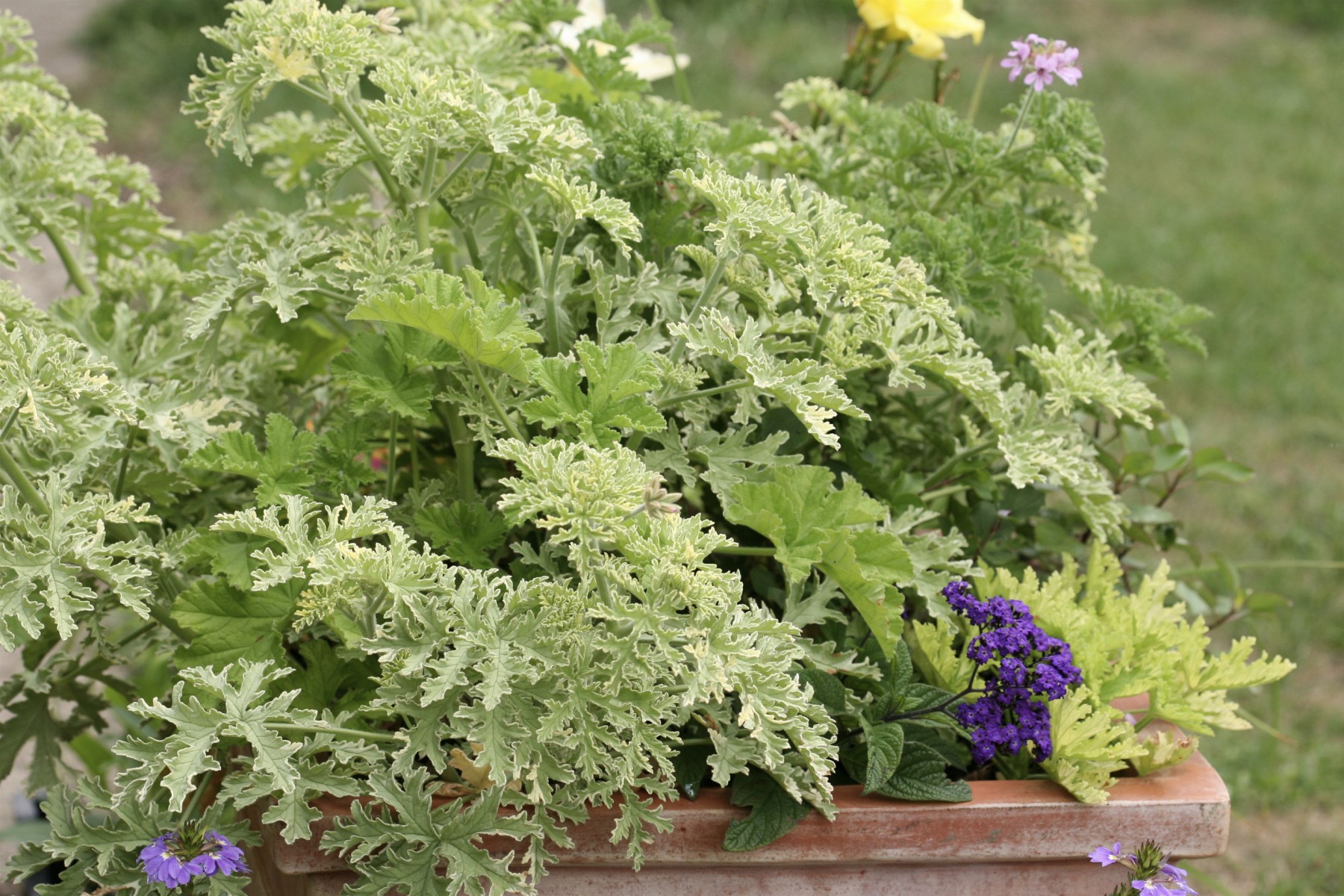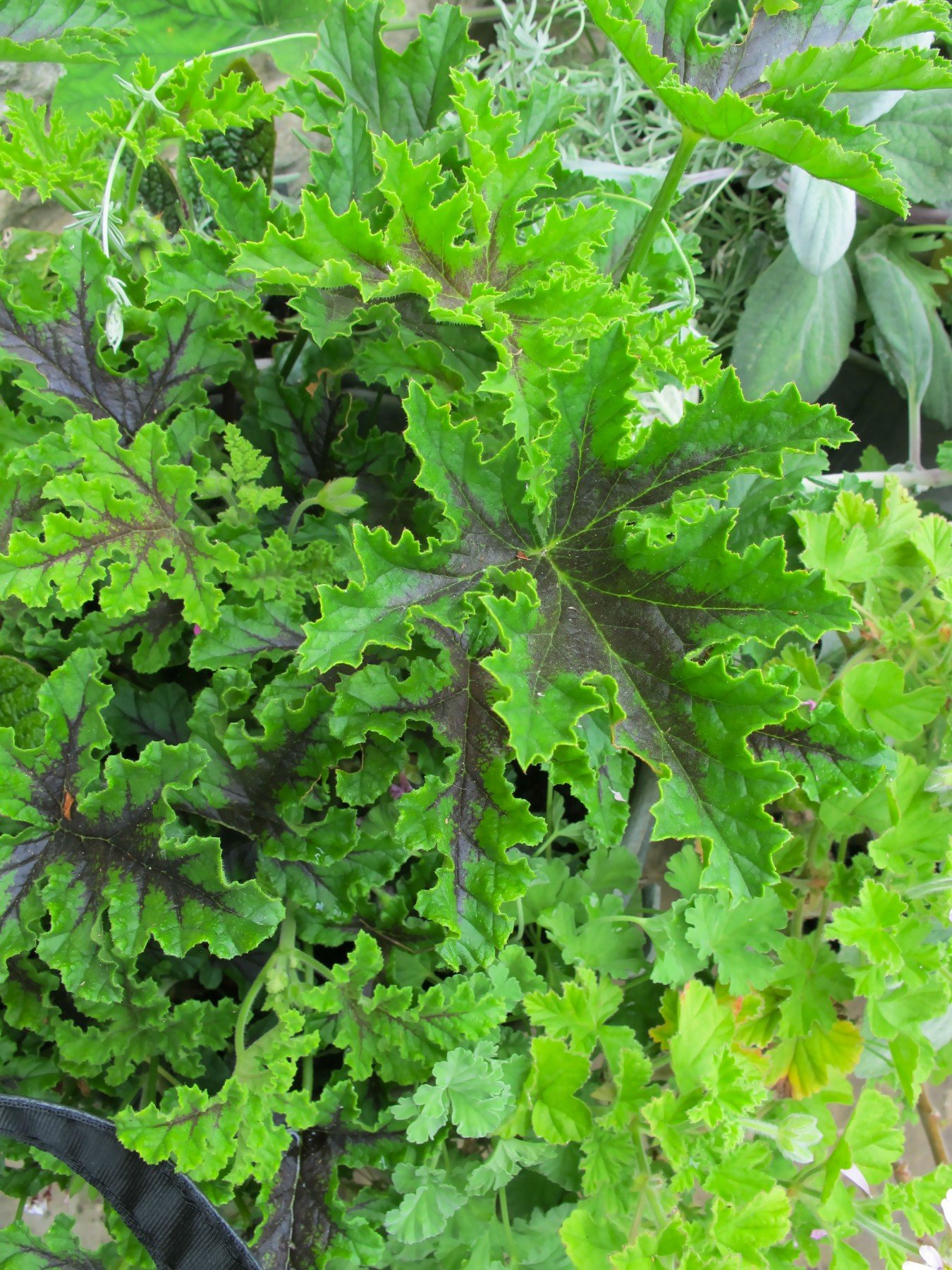
A Hartley Botanic greenhouse is not only a joy to behold, it’s also a useful gardening tool because it creates an ambient environment that encourages plant growth. And if you live where I live, in the aptly named village of Cold Aston, it’s a necessity for it’s parky up here! My greenhouse began life with a tomato or two among the flowers, but in recent years the Best Beloved has taken over with peppers, cucumbers and tomatoes in every nook and cranny, so this year I’m reclaiming some space so that MY greenhouse, NOT HIS you understand, will look lovely as well as being productive.
I’m going to grow easy greenhouse plants that look beautiful, but aren’t too time consuming because most of my day is taken up with writing and yet more writing. I’ve decided to adorn the greenhouse bench with some scented-leaved pelargoniums, grown in old terracotta pots, because they offer so many different leafy textures. Their tactile foliage releases a pungent smell which can vary between rose, peppermint, orange, cinnamon, mint or fragrant soap, according to variety. They’re amenable to a bit of neglect too so if watering is not possible, they’ll survive. Fibrex Nurseries have the best range – www.fibrex.co.uk.
On cool days you might have to rub the foliage to release the scent, but the warmth of a greenhouse, or a really hot day outside, will release the fragrance on its own so it’s rather like entering a pantry and a garden all at the same time. Most scented-leaved pelargoniums overwinter easily in a greenhouse supplied with a frost-breaking heater because they’re tough plants found growing on South Africa’s Cape, home to 250 or so species of pelargonium. I’ve seen them is South Africa and they make leggy, wiry plants, almost woody, and this a natural defence against grazing animals and the rugged South African climate. This is also why they’re drought tolerant and lovers of poor soil – so don’t overfeed them. Their name, coined by Johannes Burman in 1738, is Greek for pelargos ( meaning stork) because the seed looks like a stork’s beak. The geranium, or crane’s bill, has always been muddled up and both are often called geraniums.
Scented-leaved pelargoniums arrived in Britain in the 17th century and adorned the orangeries of the wealthy, but they were soon passed over cottage garden fences as well. Twenty varieties went to North America with the Settlers, in 1620, and a hundred years later over a hundred and twenty had been named. The Victorians bred and collected them avidly and the lemon-scented ‘Graveolens’ perfumed rooms in every suburban villa – a living, lacy-leafed pot pourri that I can remember my grandmother growing.
All the scented-leaved pelargoniums are derived from species found on the Cape. Mint-scented varieties often have P. tomentosum in their breeding line and this has soft, almost velvety leaves and these can scorch in bright sun. I tend top give any mint-scented varieties dappled shade. Some of the rose-scented varieties draw on P. capitatum, whilst the citrus-scented varieties often contain the lime-scented P. x nervosum, or the apple-scented P. odoratisserum. Most have small, darkly veined, dainty flowers held on long stems in either mauve, pink or white. These are adored by hoverflies and bees, but they do not make a huge impact on the eye. It’s the foliage that matters.
My ultimate favourite is ‘Attar of Roses’ ( 1907 Cannell and Sons), which has fuller mid-green, rose-scented leaves topped by clusters of mauve-pink flowers. It makes a bushy strong plant and four will fill a giant pot, or you can have one single specimen. The bees also love this and you can add a silver plectranthus (P. argentatus) and a purple heliotrope for contrast and put them all in a tub by a sunny door. This water-wise container will need watering about three times a week.

Another commonly grown one is the lemon-scented ’Radula’, which is often used in cooking to flavour creamy puddings. Apparently it imparts a Turkish delight flavour. The fresh-green foliage has a leathery feel and is very divided, so this is a toughie than can get very leggy. The flowers are very typically mauve-pink. ‘Grey Lady Plymouth’ also has divided foliage with silver-grey to sage-green leaves lightly edged in white. She’s very soft and feminine and easier to grow than the ‘Lady Plymouth’ for me. Finally I love ‘Clorinda’ (1907), which has cedar-scented foliage and large rounded pink flowers. It’s probably the showiest of the scented leaved pelargoniums, with substantial all-green leaves. You’ll find them easy whether they’re in the greenhouse, or in a large container and few things look as dainty and summery or smell as good.
Propagating
Pelargoniums need regular propagation because they tend to become woody, but it’s a very easy process if tackled between June and late-August. Look for new sturdy growth and remove the bud, if there is one. Trim below the node ( the bumpy bit where the stem and laves meet) and push the cutting into a small seed trays full of coarse horticultural sand, along with a clearly written label. It must be coarse horticultural sand, because fine sand dries out too quickly. You can put plenty of cuttings in each tray, leaving about an inch between each.
Cuttings of most cultivars root quickly and they can either be potted up individually in September or they can stay in the sand tray over winter. Keep the cuttings ( or pots) on the dry side and cover the trays with a double layer of thick horticultural fleece in severe weather. When potting up use clean plastic three-inch ( 9cm) round pots containing a 50% mixture of perlite or vermiculite with 50% loam-based John Innes 1. Keep new plants on the greenhouse bench, or under cover, until early June. Then plant them out. Feed with Tomarite every two weeks to encourage growth. The high-potash content also hardens the foliage helping plants to overwinter.



